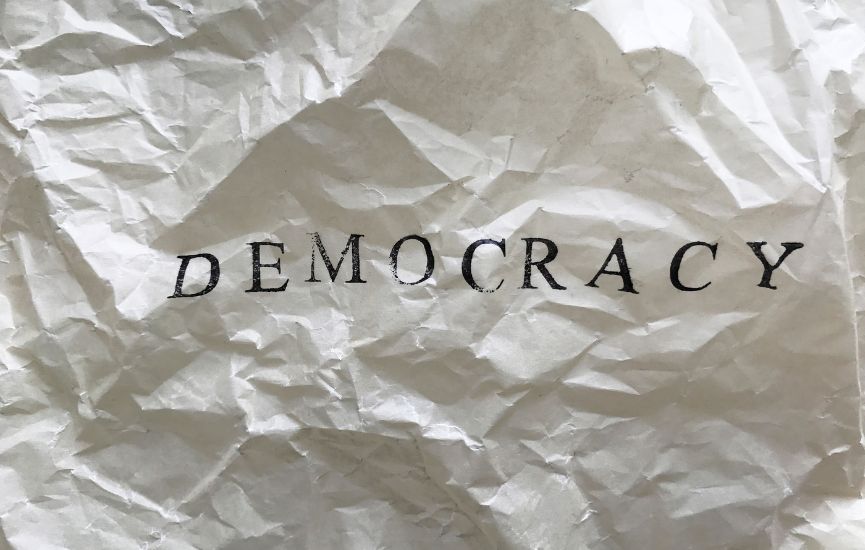Policy Recommendations
- For upcoming democratic movements: Clarify your goals and organisational structure early on and then try to become entrenched within (groups of) society. It will be a marathon, not a sprint.
- For donors and funders: You get what you pay for. If you pay for projects, you will have successful projects. But if you want a vibrant, organic civil society, consider long-term and core funding.
- For established parties and politicians: Listen to rather than discourage challenges coming from below, as long as they are pro-democratic.
Abstract
Between 2012 and 2017, successive waves of protests brought public officials to account. Governments were overthrown, and significant pieces of legislation were overturned. In 2016, a new liberal party (Save Romania Union) entered parliament, asking for the democratisation of public life and boasting its own internal democratic decision-making. In 2020, the party entered parliament and, then, the government. Events like these contributed not only to increases in the quality of democracy as measured by international indexes but also in democratic resilience.
Since then, the situation has deteriorated. The quality of democracy has declined, reaching a low point in 2021, according to V-Dem, and the government has been unable to communicate with the population effectively in successive crises. Public dissatisfaction did not manifest itself through pro-democratic protests like in the past; on the contrary, we can see an increase in the voting intention for extremist parties and a general decrease in trust in democratically oriented institutions, be they internal or international.
However, this Policy Brief notes that public pro-democratic protests have historically been slow to take off, and even when they did, they were ignited by comparatively less important issues, appearing as “black swans”. This may be due to the failure of protest movements to crystallise into permanent structures of representation and, in a more general sense, the failure of civil society to become a representative voice for the public.
As such, it is difficult to say to what extent movements from below can influence Romania’s democracy for the better. Precedents suggest that, despite apparent societal calm, the public will ultimately make its voice heard and will oppose a political class that it trusts less and less. Typically, there is a delay between the stimulus and the societal reaction, but this delay does not extend beyond parliamentary elections. Unfortunately, the current situation clearly shows that a significant part of the discontent may simply be channelled into radicalisation, and those feeling underrepresented may choose extremist parties.
****************************
Democracy from below in Romania: how far can it get before breaking
Introduction
In 2020, the GlobalFocus Center built a Democratic Resilience Index[1] to solve a paradox in the evolution of democracy within Central and Eastern Europe and beyond. While some formerly acclaimed democratic successes like Poland and Hungary were experiencing democratic backsliding, less acclaimed or troubled democracies like Romania seemed to show greater resilience, as massive protests in Bucharest had thwarted government attempts at reversing rule of law reforms and ultimately ousted the ruling party altogether at the polls. This seemed to showcase that the reasons that make a democracy blossom are not always the reasons that make it endure.
According to the index, one recursive element pushing up Romania’s scores was, loosely speaking, citizen influence from the bottom up. Romania scored higher than the other two countries in the pilot study, Hungary and Moldova, in areas like internal party democracy, trust in the judiciary system, democratic support from public media, ease of starting a media outlet/blog, liberal values in civil society, influence of civil society, influence of the diaspora, popular support for international organisations, and popular understanding of capitalism[2] while communist melancholia was hardly present.
Other indicators are not explicitly a form of bottom-up influence, but they are strongly related to it. The balance of power, for example, owes much to the phenomenon of alternation of power induced by elections, which has not allowed any party to consolidate power over the state to the levels achieved by Fidesz (Hungarian Civic Alliance / Magyar Polgári Szövetség) in Hungary and PiS (Law and Justice / Prawo i Sprawiedliwość) in Poland.
Democracy from below used to work
This optimistic outlook on democratisation from below reflected actual events in recent history. To speak of the most recent ones, in 2017, unprecedented crowds took to the streets in protests that lasted for half a month to protest against a legislative package collectively known as Emergency Decree 13 (OUG 13). This package decriminalised certain abusive decisions taken by public officials and pardoned others. It was perceived as a plan to favour the political apparatus of the governing Social Democrats and, personally, the president of the party, Liviu Dragnea, who had legal problems and was eventually sentenced for corruption.[3] Due to the protests, the package was abandoned before it could produce any effects, even though the Social Democrats tried to impose similar measures through other means.
Then, in 2018, a proposal to enshrine heterosexual-only marriage into the constitution[4] adopted by parliament failed to pass a referendum (due to a lack of quorum), despite support from the two main parties and most of the churches and religious organisations in Romania.[5] This was a strong rebuke to previous claims by the proponents of the change that the Romanian silent majority was inherently ultra-conservative and supported such a measure.
These were not isolated incidents of checking executive or legislative power from below. Protests (2012 on healthcare/anti-government, 2013 on the environment, 2015 on anti-corruption) appeared to be stronger with each iteration and created the expectation that elected officials could not stray too far from some basic expectations of the population.
Where are we now?
According to V-Dem,[6] the quality of democracy in Romania again took a downward turn in 2022. But this time it did not result in a reaction from the population of the sort described above. In fact, public pressure decreased or lost effectiveness in 2022 as compared with 2021, as seen in V-Dem[7] in indicators such as the participatory component (0.73 to 0.69), civil society participation index (0.77 to 0.73), or engaged society (0.81 to 0.31).
According to V-Dem, the quality of democracy in Romania again took a downward turn in 2022.
The far-right AUR party (Alliance for the Unity of Romanians) consolidated its popular support in a range between 15% and 20%,[8] while the SOS Romania party (a wordplay on the name Șoșoacă and the SOS signal), which combines far-right themes with open support for Russia, has gathered 4% in at least one poll.[9]
The new far-right parties (AUR, SOS) are constructed on the populist charisma of their respective leaders rather than around a principle of democratic representation.
Internal party democracy is also fading. The PNL (National Liberal Party / Partidul Național Liberal) seems to be disciplined and obedient to its informal leader, the president of the country, Klaus Iohannis, even though, constitutionally, he’s not allowed to be head of the party. The leadership of the Save Romania Union, once a beacon of internal democracy, has not been able to keep its own ranks together, never mind its electorate.[10] The new far-right parties (AUR, SOS) are constructed on the populist charisma of their respective leaders rather than around a principle of democratic representation.
Simultaneously, trust in internal and international institutions is generally falling.[11]
How did we get here?
Analysis reveals a combination of reasons that make Romania a more vulnerable democracy in 2023 and act as a (temporary?) deterrent to bottom-up pressure. These can be structural, contextual, and based on elite errors.
An important structural reason is that these movements from below have failed to build stable institutions. This relates to a larger failure of representative institutions in Romania. Trade unions have minimal influence outside the civil service and state economy[12]. They are often seen as serving their leaders instead of their members.[13] Non-governmental organisations have low membership numbers.[14] Internal party democracy is also problematic, as mentioned above. The main churches officially stay clear of politics and politically relevant civic action, and when they have a politically relevant position, this is often illiberal in nature, like in the case of the 2018 referendum.
An important structural reason is that these movements from below have failed to build stable institutions.
Even the protests from 2012 (anti-government, anti-austerity), 2013 (ecological, anti-corruption), 2014 (anti-corruption), and 2017 (anti-corruption) were essentially leaderless; this was more of a feature than a bug. Interviews with protesters indicated that anyone positioning themselves as leaders would risk being distrusted and pushed out of the movement.
Against the background of these structural problems, Romanian democracy has been tested by a series of successive crises, including the COVID-19 pandemic, the war in Ukraine with the associated refugee crisis, and inflation.
Politicians and the state elite failed to communicate effectively, leaving room for extremist forces to exploit the weaknesses of democracy. Thus, even when Romanian politicians made reasonable decisions, they often gave the impression that they were doing so against their will. For example, during the pandemic crisis, the prime minister was photographed without a mask, casually chatting with some of his associates,[15] in contradiction to recent government decisions. A similar situation occurred with the health minister.[16] Regarding support for Ukraine, Romania’s repeated position is that it is imprudent for the government to declare any specific details about the aid given to Ukraine.[17] Also, the government has offered significant[18] support for refugees in 2022 while avoiding communicating about it.[19]
Politicians and the state elite failed to communicate effectively, leaving room for extremist forces to exploit the weaknesses of democracy.
Due to the silence and incoherence of mainstream political actors, the main beneficiaries of these crises were the AUR party, which has been able to mobilise the dissatisfaction of a large part of the population around a populist and nationalist agenda, and SOS, the party of member of parliament Diana Șoșoacă, former AUR member and open supporter of the Kremlin.
Delayed reaction?
In the absence of visible public pressure or actions by authorities to take this pressure into account, dissatisfaction is likely to accumulate and, if the recent past is an indicator, boil over. It may well be that in the near future, most likely before the parliamentary elections in 2024, we will have massive waves of public dissatisfaction starting from apparently unimportant issues that will serve as sparks that ignite existing grievances in society.[20]
The precedents in this regard are significant. The 2012 protests were a delayed reaction to austerity measures but started with a fairly specific change in the healthcare law. The 2013 protests are interpreted by most commentators as having a strong anti-corruption component, despite being nominally motivated by environmental issues. Going further back in time, the Romanian anti-communist revolution of 1989 came the latest in the region, but was the most violent, sparked by a conflict between local authorities in the city of Timișoara and a priest of Hungarian ethnicity.
Metaphorically speaking, Romanian society may appear silent, but it is rather speech-impaired.
Such accumulate-and-release developments are perhaps natural in a situation where, as mentioned earlier, public discontent has no continuous, institutional channels of expression. Metaphorically speaking, Romanian society may appear silent, but it is rather speech-impaired.
Conclusion
We can learn from the case of Romania that highly decentralised, leaderless mobilisation strategies are a double-edged sword. On the one hand, they allow democratic movements to organise even in countries like Romania, where interpersonal trust is low. On the other hand, such movements often lack staying power, allowing established politicians to wait them out.
Another lesson is that politicians who take advantage of the lack of organisation within grassroots movements do so at their own risk. If they choose to ignore the underlying dissatisfaction of the population, then other forces will fill in the void of representation. Sometimes these forces can be democrats and liberals, but other times they will be populists and extremists.
****************************



[1] https://www.global-focus.eu/wp-content/uploads/2021/09/Democratic-Resilience-Index.pdf
[2] https://www.global-focus.eu/wp-content/uploads/2021/09/Democratic-Resilience-Index.pdf, p. 26-27.
[3] According to the principle of the most favourable penal law, that is, incrementation would have impacted past deeds.
[4] Heterosexual marriage was already deemed to be the only constitutional form of marriage according to the interpretation of the Constitutional Court, so the referendum appeared to many to be an effort to mainstream ultra-conservative and illiberal Western values and to put religious values at the core of the law. It was supported with various degrees of enthusiasm by the two main political parties, the Social Democrats and the Liberals.
[5] https://www.rferl.org/a/romania-same-sex-marriage-referendum-low-turnout-dragnea/29529342.html
[6] https://v-dem.net/data_analysis/CountryGraph/
[8] As compared with 9% in the election.
[9] https://curs.ro/sondaj-de-opinie-la-nivel-national-martie-2023/
[10] A new party was formed with people leaving the Union. And the remaining leadership has been accused of capturing the party.
[11] https://dc360.ro/sondaj-curs-increderea-in-institutii-la-pamant-cea-mai-redusa-cota-de-incredere-in-partidele-politice-de-pana-acum-doar-7-increderea-in-parlament-la-minimul-istoric-de-10-bor-scade-nu-mai-putin/
[12] See: revistadesociologie.ro; DINAMICA ŞI PERCEPŢIA MIŞCĂRII SINDICALE ÎN ROMÂNIA POSTDECEMBRISTĂ, p. 15. https://www.revistadesociologie.ro/pdf-uri/nr.5-6-2001/ANDREEA%20%20NICOLAESCU,%20art4.pdf
[13] https://library.fes.de/pdf-files/bueros/bukarest/19247.pdf, p. 34.
[14] https://green-report.ro/voluntariatul-in-romania/
[15] https://www.reuters.com/article/health-coronavirus-romania-pm-idINKBN237031
[16] https://www.gandul.ro/coronavirus/video-vlad-voiculescu-ministrul-sanatatii-surprins-fara-masca-pe-holurile-parlamentului-19608520
[17] https://www.bbc.co.uk/programmes/p0fcxsjz. This position diverges from the positions of all NATO allies, and no specific justification has ever been offered.
[18] According to reports from the ground, refugees migrated from Bulgaria to Romania.
[19] During discussions with the people responsible, it has been suggested that they fear there will be a strong negative reaction from the population. No survey or research is known that supports this position.
[20] During the time we worked on this Policy Brief teachers went to a general strike (https://www.euronews.com/2023/06/09/exams-in-romania-postponed-as-thousands-of-teachers-strike-for-better-pay) bringing at least 10 000 people to the streets. The far-right AUR party also proved able to bring to Bucharest around 10 000 people for a populist protest, some of which turned violent (https://www.romania-insider.com/supporters-aur-turn-violent-during-protest-parliament-bucharest).
About the article
ISSN 2305-2635
The views expressed in this publication are those of the author and not necessarily those of the Austrian Society of European Politics or the organisation for which the author is working.
Keywords
Romania, democracy, democratic resilience, protests, democratic movements
Citation
Tiut, A. (2023). Democracy from below in Romania: how far can it get before breaking. Vienna. ÖGfE Policy Brief, 21’2023







